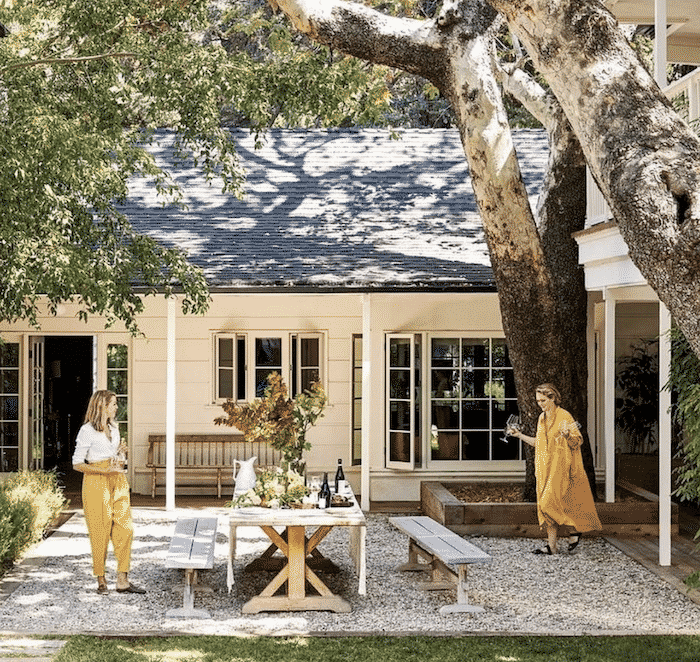Buying a house jointly with parents or other family members in Australia makes it easier to enter the property market.
In 2025, with higher property prices and banks making it harder for people to borrow as much money as they used to, buying a house with family members or friends just makes more sense sometimes.
Buying property with family members provides each of you with many benefits, including:
- Buy sooner – no need to wait several more years to save your deposit;
- More choice – with a bigger combined budget, you can look at bigger properties in better areas;
- Lower financial commitment – each family member can contribute a smaller deposit, and have lower home loan repayments.
You might be interested to read the interview I did with realestate.com.au or listen to the interview I did with The Real Estate Podcast.
A typical home loan taken out when buying property with your partner is called a ‘joint home loan’.
When a ‘committed’ couple buy a home or investment property together, they take out what is called a ‘joint home loan‘. Typically joint home loans are designed for ‘couple’s or families where each person’s finances are entwined together. The couple usually share a bank account and all expenses, assets and liabilities are viewed as being equal and joint.
This works really well for those who are comfortable and feel secure buying a house jointly with parents in Australia, but not everyone wants their finances to be intertwined.
You may also like this post on the top 13 game changing tips for a first home buyer, or this one on how to make an offer on a home or the step by step guide to buying a home.
When investing in property with family members, consider a ‘property share home loan’ instead.
Increasingly we are seeing couples, families or friends considering buying property together, so the typical home loan where finances, goals and lives are entwined doesn’t suit their needs.
A ‘property share loan’ will mean you you don’t need to have your finances completely entwined.
A property share loan can be suitable if you are considering buying a home or investment property with:
- Siblings, parents, other family;
- A friend; or
- A partner you are in a relationship with but want to keep your financial independence.
Property share home loans are a good option to consider when:
- It makes financial sense to buy together
- But you would also like to maintain financial independence

You can meet with me to talk about buying property with family, at either South Brisbane or Burleigh Heads. [pic – Victor Kalinowski, Mortgage Broker at Blackk Mortgage Brokers].
Can Siblings Buy a House Together? Let’s Take A Look At How That Might Work
To best show you how beneficial a property share loan can be, I’ll use a case study based two sisters, Lauren and Pamela. They have three options:
- Option 1: ‘Going it alone’, where both Pamela and Lauren buy their own separate homes and have separate home loans; or
- Option 2: The sisters buy a property together in the standard way with a ‘joint home loan’; or
- Option 3: The sisters buy a property together using a ‘property share home loan’.
In their situation, I recommend option 3, the property share home loan.
Remember google isn’t your only tool, so please book a free 15minute call with me here so we can talk about your personal situation in more detail.
Here is a profile of each of the siblings looking to buy a house together:
About Lauren
Lauren is 31 and single, working as a team leader in a travel agent in the Brisbane inner city. She earns $88,000 per annum (gross) and has a house deposit saved of $56,000. Lauren is hoping to meet a partner, get married and have her own family.
Lauren has a credit card with a limit of $6,000, and as she lives with her parents, she pays no rent. Lauren’s monthly living expenses are approx. $1,200 on essentials like food, bills, board and a further $800 on discretionary spending like social life, clothing and beauty.
About Pamela
Pamela is 28, and is a private school teacher earning $79,000 each year (gross), with a house deposit of $67,000 saved.
Pamela has a credit card with a limit of $1,000, and has a personal loan for a car of $14,300 where she is repaying $289 each month. Like her sister, she also lives at home with her parents to save on rent. Her monthly living expenses are approx. $900 on essentials like food, bills, board and a further $500 on discretionary spending such as social life and clothing. Again like her sister, Pamela would like to meet a partner and have children in the future.
You may like this post on the top 13 game changing tips for a first home buyer, or this one on how to make an offer on a home or the step by step guide to buying a home.

A property share loan will mean you can buy property together without completely entwining your finances.
Option 1: Each sister buying their own separate properties.
Based on their personal circumstances, here is how much they can borrow (see table below):
- Lauren can borrow up to $539,000 and would repay $615 each week on her loan
- Pamela can borrow up to $448,000 and would repay $511 each week
Each sister buying their own separate properties.
Maximum amount each sister can borrow and Weekly Repayments
*Assumes an interest rate of 4.30%, loan term 30 years
Upsides of buying separately:
- Complete freedom with each sister in her own property
- No future complications
Downsides of buying separately:
- Based on the current Brisbane market, each sister can only afford a 2 bedroom unit or a small older house, as they can only borrow $539,000 and $448,000 respectively.

When buying property with family members, I recommend you consider a property share loan rather than the typical ‘joint home loan’.
Option 2: Getting a ‘joint home loan’.
This has traditionally been the most common approach to buying property with someone, either a partner or a family member.
In this situation, there is one home loan that both siblings are applicants for. The loan is based upon the combined financial strength of both parties.
The results when buying as a joint loan (table below)
- Bigger joint borrowing capacity, borrowing up to $961,000
- Add on the combined deposit saved of $122,000, so the maximum amount they have to spend on a home and buying costs is $1,083,000 (ie 961,000 + $122,000)
- Buying costs (stamp duty, solicitors fees, transfer fees etc) of $22,000
Getting a "joint home loan".
Results when buying as a joint loan
What to do when siblings have different deposits to contribute
Lauren has saved $56,000 as a deposit, which is less than her sister Pamela at $67,000, however, they both want to own the property 50/50.
This means Lauren will need to borrow slightly more than her sister (see table below).
Lauren borrows $485,000 and Pamela borrows $474,000 (if they had equal deposits they would borrow $541,000 each).
Lauren’s loan repayments will be higher at $554 a week and Pamela’s are $541.
Different deposits
What to do when siblings have different deposits to contribute
*Assumes an interest rate of 4.30%, loan term 30 years
Tip: avoid the temptation to borrow the maximum amount you are approved for.
In this situation, I would not recommend for Lauren and Pamela to borrow the full $961,000.
This is because the purpose of buying property with family is to make the loan repayments more manageable and, at the same time, buy a better home.
If they borrowed the full $961,000, I feel this loan to big for them to manage, especially if interest rates rise or there are unexpected costs in their lives (which is likely).
Tip: it’s better to borrow an amount you feel comfortable repaying.
Instead, Lauren and Pamela decided on a house in Greenslopes for $710,000.
After adding on costs of buying, the total amount needed is $732,000.
Using their full deposit of $122,000, this means they now need to borrow $610,000.
Cost of house: $710,000
Costs of buying: $22,000
Total amount needed: $732,000
LESS: Deposit $122,000
Total loan required $610,000
Since Lauren is putting in less of a deposit compared to Pamela, she now needs to borrow slightly more money.
With the adjusted loan amounts, Lauren ends up borrowing $249,000 and repaying $284 each week (see table below).
Pamela borrows $238,000 and repays $272 each week.
Compared to the baseline scenario I covered above (where the sisters buy property separately). this option with a joint loan is far more manageable financially.
Joint loans
A joint loan is far more manageable financially
*Assumes an interest rate of 4.30%, loan term 30 years
Upsides of a joint loan compared to buying separately
- Combined buying power means a better house in a better suburb (if they were to borrow the full amount)
- Lower weekly repayments
- Allows them to own a share in a house in a better position rather than a unit
Downsides of a joint loan compared to buying separately
This is one of the most important facts to understand about getting this type of joint loan.
- The bank will hold each sibling liable for the full loan of $610,000 – this is the major downside of a joint loan. It impacts you if, say if one of you loses your job, you have a fall so runs away and can’t pay your share of the loan, then the other partner will be fully liable for both shares of repayments; and
- If one sibling wants to buy another home, for example, if your settling down with a partner, then your borrowing capacity is greatly reduced.
Nearly all banks and financial institutions will calculate your borrowing capacity as already having a $610,000 loan.
This is very likely to mean that you won’t be borrowing much money in the future as you will be reaching your ‘borrowing capacity’ (the maximum amount you can borrow).
This could be an issue if, for example, you wanted to chat with a refinance broker or buy with your wife/partner (and keep this house with your family).
Option 3: ‘Property share loan’ (recommended).
A property share loan is different from the traditional joint loan as shown in option 1 as:
- Each applicant has their own separate home loan
- Both loans are secured against the same property.
This is only offered by one bank.
The numbers when buying as a property share loan
Using the same situation as in Option 1, where they purchased a house in Greenslopes for $710,000, the numbers are the same.
House price: $710,000
Costs to buy: $22,000
Total (house + costs of buying) : $732,000
Property share loan
The numbers when buying as a property share loan
*Assumes an interest rate of 4.30%, loan term 30 years
Upsides of property share loans
Major benefits as to why I recommend this type of loan:
- You each have a smaller loan – this is the MAJOR benefit when you go to buy another property in the future, say with a new partner because your borrowing capacity isn’t significantly reduced. The bank will only account for your half of the loan so Lauren will be assessed as having already borrowed $249,000 (compared with the $610,000 she would have against her name if she went with option 1).
- Each person can pay out their loan in their own time – so if you want to make extra repayment but your sister doesn’t, you take all the benefit of paying your share off sooner.
Downsides of property share loans
- Currently, only one bank offers this type of home loan;
- Each person has to apply individually for their own home loan – this means both loans have to be approved in order for the home purchase to be approved at the same time.
So if one of you has a bad credit history from not paying bills or credit cards on time, for example, then it will affect both of you as they may not be able to get a loan.
Buying property with family members: wrap up
By now I hope the benefits of buying a house with parents or siblings are obvious!
The key points to know are that it propels you into the property market sooner, and with the Property Share Loan, you can be sure you’re each protected.
Remember that google isn’t your only research tool, as you can book a free 15min strategy call with me here to discuss your personal situation in more detail.
You may like this post on the top 13 game changing tips for a first home buyer, or this one on how to make an offer on a home or the step by step guide to buying a home.

The information contained within this page is general in nature. It serves as a guide only and does not take into account your personal financial needs. Before you act on this information, you should seek independent legal and financial advice or speak to Blackk Mortgage Brokers Brisbane.







